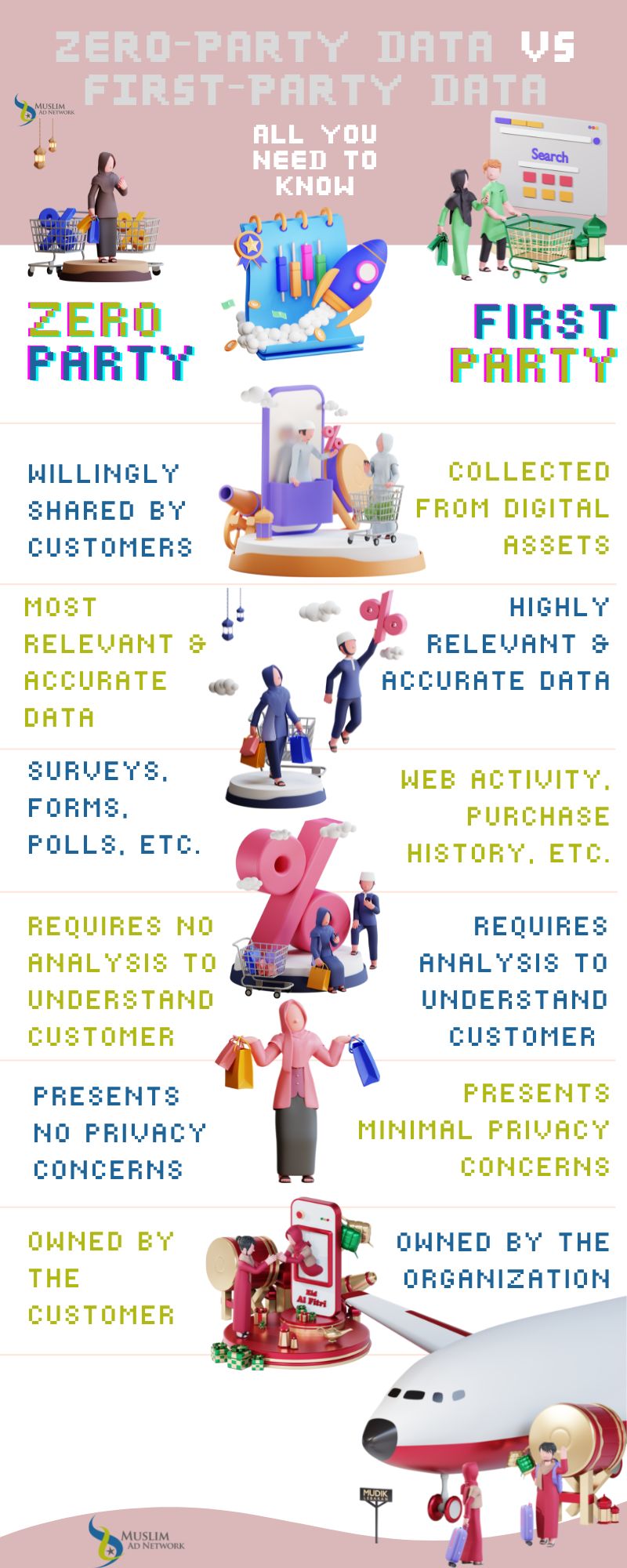
What is Zero-party Data?
Zero-party data is information that your Muslim customer voluntarily gives to your marketing or sales team. It includes details your customer wants your halal brand to be aware of about them, like physical traits such as size, fashion preferences, and purchase intentions.
- Your Muslim brand can only benefit from zero-party data if it can link it to a first-party customer profile. This means it must be gathered after users have registered or logged in on digital properties to prove their identity.
- Since customers voluntarily share it, it is entirely permission-based. The permissibility for the use of this data for segmentation of your Muslim audience, personalization engines, or product recommendation tools is clear-cut for your brand as a result.
Zero-party Data vs. First-party data
The frequent confusion between zero and first-party data necessitates a comparison section in this article. Understandably, since first-party data was previously thought to include zero-party data, it can initially be a bit confusing.
You can gather first-party data through indirect interactions with your customers. Tactics may include on-page, app-wide, and site-wide behaviors. Examples of such data include time spent actively on the page, hovering, scrolling, or sales information, such as personal details, purchase history, discounts used, and subscription periods. This is comparable to when you carry out quantitative research.
The same objective is pursued by zero-party data, which is produced by directly soliciting customer preferences. The interactions can take place in preference centers, on social media sites, in mobile apps, or on websites. The tactics are direct and more closely resemble qualitative research.
There is sometimes an overlap between the two types of data. For example, if you own a modest fashion website, you might learn a customer’s color combination preference if they buy a hijab and a dress. That’s first-party data. However, unless they also purchased pants, you may not know their waist size. As a result, if you ask for their waist size in an email for any reason, you are collecting zero-party data.
In short, zero-party data is information gathered outside of standard eCommerce transaction procedures. If you ask your customer about themselves or their interests, you are collecting zero-party data. When a customer enters their address to complete a purchase, that is first-party data.

More Types of Data
Second-party data
Second-party data is your Muslim brand’s first-party data that you sell to another brand that is trying to bring in customers based on specific data.
Second-party data is not openly available. Instead, you must establish a relationship with another company and negotiate a deal in which data is exchanged. With this type of data, you can access much more niche and specialized data. It tends to be of better quality than third-party data but smaller in scope.
Having a strategic set of data through a private partnership can be ideal when reaching out to specific markets with a new product or branding direction. For example, if an Islamic finance company teams up with a halal travel company to create a destination-specific credit card with zero interest, the Islamic finance company can see customer data related to Muslim traveling habits and preferences to create targeted ad campaigns for certain types of travelers.
Third-party data
You can purchase third-party data information from data aggregators, and advertisers, or by running tracking ads with companies like Facebook and Instagram.
By having access to large pools of data or running ads that track people’s data, you can gain information from people you have no previous relationship with that interacted with your business without registering or buying anything.
However, come 2024, this type of data will not be available readily if at all. You can find more information here:
Google says it will definitely ditch cookies…by 2024
Advertising to Muslims Online in 2024 After Third-Party Cookies Disappear
Creating Your Muslim Business’s Zero-party Data Strategy
Let us now look at how to manage a successful zero-party data strategy that generates sufficient engagement from your Muslim customers.
- This should go without saying, but make sure your zero-party strategy is in sync with your overall marketing and advertising strategy. Zero-party data must be integrated into all of your marketing efforts. Make certain that your channels, campaigns, and analytics all work together to deliver a customer experience that exceeds audience expectations.
- Integrate existing systems to combine your zero-party data with your first-party data. Data silos should not be allowed to undermine your marketing and advertising strategy.
- Make your customers understand the value exchange. Inform them about how your company will use their information and how it will improve their shopping experience for your Muslim-friendly products.
- Integrate zero-party data into your overall omnichannel experience. Collecting zero-party data is all about customer interaction, and there are numerous channels and methods for providing valuable customer connections — whether through direct mail, WhatsApp campaigns, or other means.
9 Ways of Collecting Zero-party Data
- Social media polls
- Contests
- Account creation
- User profile completion prompts
- Rate and review purchases
- Quizzes
- Conversational pop-ups
- Post-purchase surveys
- Product onboarding
Keep the Future of Zero-party Data Top of Mind
We are clearly advancing toward more interactivity, personalization, and a more participatory customer experience. This new interactive mindset will rely heavily on zero-party data. Consumers will want to share their data with other users—and brands—in the metaverse in order to create more engaging experiences.
With the introduction of zero-party data, Muslim users will be more likely to share their information with your brand once they trust you. Your Muslim customer base will be more likely to share their information voluntarily with zero-party data, and this information will be more reliable and trustworthy than the third-party data you have been using.
You will be able to create more engaging customer experiences if you use zero-party data, and you will also be better positioned to compete in the new Web3 and metaverse era.
Conclusion
Incorporating zero-party data into your strategy means you can be well on your way to optimizing your campaign personalization efforts, which in turn makes your brand more reliable, more trustworthy, and more favorable for your Muslim consumer. By understanding their needs on a deeper level, you’re able to connect your consumers with the products they desire whilst facilitating and maintaining brand loyalty. In years to come, brands will become increasingly reliant on data they can trust so, ultimately, the importance of zero-party data will continue to grow in the years ahead. Personalization isn’t the future – it’s the now, and it’s vital for your marketing efforts to be more effective.
start targeting muslim consumers